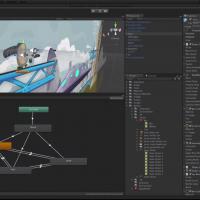Unity
Item
- Title
- Description
- Form filler
- Creator and affiliation
- Current ownership type
- Year of first release
- End-product media type(s)
- Main target audience(s)
- Available modes of creation
- Role of coding in creative process
- Life status
- Product portal
- Homepage URL
- Reference citations/URL(s)
- Use license cost
- Publishing license model
- Programming language written in
- Author-facing programming/scripting language(s)
- Authoring tool work platform(s)
- End-product work platform(s)
- Available supporting technical resource(s)
- Self-containment
- Primary design focus
- Primary authoring action(s)
- Main interface window(s)
- Designable general element(s)
- Designable narrative specific element(s)
- Built-in preset element(s)
- Overall difficulty assessment
- Work environment/design interface intuitiveness
- Learning curve complexity
- Advanced authoring complexity
- Depth of advanced authoring
- Degree of narrative specific emphasis
- Role of procedural authoring
- Types of available procedural authoring
- End-product control interface
- Additional key interaction design affordance(s)
-
Unity
-
Unity is a cross-platform game engine developed by Unity Technologies which grew to become the most widely used all-purpose game creation engine. Most recognized with 3D game development the engine is also commonly used for 2D and mobile game development as well as XR media interactive simulations and other experiences. It is cited to be easy to use for beginner developers and is popular for Indie game development as well as AAA game development (products include Pokémon Go Call of Duty Beat Saber and Cuphead).
While not emphasizing narrative authoring a high amount of narrative games are written with Unity due to the tool's popularity and plugins such as Fungus enable a more narrative-centered work environment.
-
Yotam Shibolet
-
Unity Technologies (Funded in Denmark 2004)
-
Fully private
-
2005
-
Real-time graphics
-
XR (Virtual/augmented/mixed reality)
-
Amateurs/enthusiasts
-
Professional interactive narrative authors
-
Programmers (no creative background)-targeted tool
-
Spatial creation mode (e.g. Unity)
-
Optional
-
Alive (actively moderated and updated and/or active community of authors)
-
https://en.wikipedia.org/wiki/List_of_Unity_games
-
https://unity3d.com/
-
Creighton Ryan Henson. Unity 3D game development by example: A Seat-of-your-pants manual for building fun groovy little games quickly. Packt Publishing Ltd 2010.
Haas John. "A history of the unity game engine." Diss. WORCESTER POLYTECHNIC INSTITUTE (2014).
Šmíd Antonín. "Comparison of unity and unreal engine." Czech Technical University in Prague (2017): 41-61.
-
Free license
-
Unrestricted publishing
-
Written in C++
-
C/C# authoring
-
UnitScript
-
Windows
-
Mac
-
Linux
-
PC/Macintosh support
-
PlayStation support
-
XBox support
-
Switch support
-
Android support
-
Browser support
-
iOS support
-
VR/XR consoles
-
https://assetstore.unity.com/
-
Self-contained with optional plugins/assets
-
Space (environment design)
-
Drag & drop (visual templates - e.g. RPGMaker- Unity)
-
Programming language coding (e.g. Javascript)
-
Navigating text menus
-
WYSIWYG (what you see is what you get) layout
-
3D space editor
-
Text-based authoring/coding layout
-
Customization menus
-
Nodes and links structure (any medium)
-
Video segments
-
Audio/sound
-
Animations
-
Movement affordances
-
Props/items
-
Rules/Constraints
-
Events
-
Physics system/objects
-
Environmental/Character States
-
Camera controls
-
Control customization
-
Available plugins (e.g. Fungus) enable all of the above
-
Interaction model presets
-
Menu presets
-
All of the above are available via the asset store
-
Medium authoring difficulty
-
Highly intuitive
-
Hard to learn
-
High complexity
-
Large depth
-
Nonexistent narrative-specific emphasis
-
Optional procedural authoring
-
Environment
-
Objects/Items
-
Mouse & keyboard
-
Physical controllers (joystick touchscreen steering wheel gamepad etc.)
-
Motion controllers
-
Gestural capture interface
-
Audio interface
-
QR Code/RFID/other AR scanning
-
Multiplayer support
-
Geo-referencing
-
Locational detection
- Item sets
